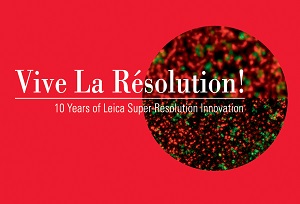The introduction of the Leica TCS SP8 STED 3X in 2014 marks Leica Microsystems’ 10th anniversary of leading innovations in super-resolution technology.
 Leica Microsystems celebrates 10 years of super-resolution innovation.
Leica Microsystems celebrates 10 years of super-resolution innovation.
“Leica Microsystems was by far the first company to take the breakthrough of the diffraction limit in light microscopy and implement this in products,” says Professor Stefan W. Hell, Director at the Max Planck Institute for Biophysical Chemistry in Goettingen, Germany, and the father of super-resolution technology. The latest generation of Leica Microsystems’ super-resolution systems, Leica TCS SP8 STED 3X and Leica SR GSD 3D, will be presented at the FOM (Focus on Microcopy) from 13 to 16 April in Sydney, Australia.
In 2004, Leica Microsystems revolutionized light microscopy with the introduction of the first commercial super-resolution microscope, Leica TCS 4PI. Super-resolution technology enables researchers to image structures in a range down to the molecular level. During the last ten years, Leica Microsystems has continuously developed its super-resolution portfolio and today offers both confocal and widefield super-resolution technologies: STED (STimulated Emission Depletion) and GSDIM/dSTORM (Ground State Depletion followed by Individual Molecule return/direct Stochastic Optical Reconstruction Microscopy).
Leica Microsystems developed its super-resolution microscopes in close cooperation with Professor Stefan W. Hell, who was awarded Deutscher Zukunftspreis (German Future Prize) in 2006 for the invention of STED nanoscopy. More awards for Leica Microsystems’ groundbreaking innovations – such as Innovationspreis der deutschen Wirtschaft (German Business Award) in 2005 for the Leica TCS 4PI, the R&D 100 Award in 2012 for the Leica SR GSD and the Top 10 Innovations Award in 2013 for the Leica SR GSD 3D – underline the importance of super-resolution microscopy for life sciences. Leading scientists in the field believe super-resolution will be standard in the near future. “Within a couple of years, the super-resolution method will be the must for all cell biologists”, explains Dr. Yasushi Okada from the RIKEN Quantitative Biology Center, in Osaka, Japan, a user of a STED microscope from Leica Microsystems.
With the establishement of the European Super-Resolution User Club, Leica Microsystems annually provides an open and informative platform and room for exchanging experiences for STED and GSD users on all aspects of super-resolution.